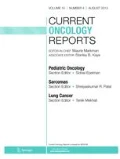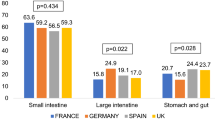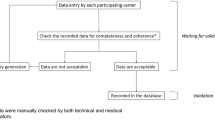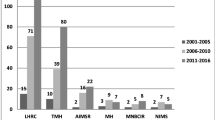Abstract
Purpose of Review
The purpose of our review is to explore global epidemiologic trends of gastroenteropancreatic (GEP) neuroendocrine tumors (NETs). Specifically, we sought to examine whether there are differences in incidence, prevalence, distribution (by primary tumor site, tumor grade, tumor stage at presentation), and overall survival of GEP NETs between different regions of the world.
Recent Findings
GEP NET incidence rates are rising steadily in North America, Asia, and Europe, though this rise appears to be most profound in North America. The distribution of GEP NETs differs regionally as in North America small intestinal and rectal NETs are most prevalent, in Asia rectal and pancreatic NETs are most prevalent, and in Europe small intestinal and pancreatic NETs are most prevalent. Overall survival for patients with GEP NETs appears to be improving with time.
Summary
Some of the global increase in GEP NET incidence can be explained by increased health care utilization. This factor alone, however, does not explain the rise completely. Population-based studies utilizing uniform data collection instruments and a standard pathologic grading system are needed to identify other factors which may be contributing to this phenomenon.
Similar content being viewed by others
References
Papers of particular interest, published recently, have been highlighted as: • Of importance •• Of major importance
Yao JC, Hassan M, Phan A, Dagohoy C, Leary C, Mares J, et al. One hundred years after “carcinoid”: epidemiology of and prognostic factors for neuroendocrine tumors in 35,825 cases in the United States. J Clin Oncol. 2008;26(18):3063–72.
Sorbye H, Strosberg J, Baudin E, Klimstra D, Yao J. Gastroenteropancreatic high-grade neuroendocrine carcinoma. Cancer. 2014;120(18):2814–23.
Leoncini E, Boffetta P, Shafir M, Aleksovska K, Boccia S, Rindi G. Increased incidence trend of low-grade and high-grade neuroendocrine neoplasms. Endocrine. 2017;58:368–79.
Chauhan A, Kohn E, Del Rivero J. Neuroendocrine tumors-less well known, often misunderstood, and rapidly growing in incidence. JAMA Oncol. 2020;6(1):21–2 An important recent publication highlighting the disease prevalence of gastrointestinal NETs and further all NETs in the United States. This publication suggests the public health importance of NETs.
Cives M, Strosberg J. Gastroenteropancreatic neuroendocrine tumors. CA Cancer J Clin. 2018;68(6):471–87.
Dasari A, Shen C, Halperin D, Zhao B, Zhou S, Xu Y, et al. Trends in the incidence, prevalence, and survival outcomes in patients with neuroendocrine tumors in the United States. JAMA Oncol. 2017;3(10):1335–42 The largest published SEER database query which led to crucial insights about the rising incidence of NETs and GEP NETs and improved OS of NET patients over time.
Dasari A, Mehta K, Sorbye H, Yao J. Gastroenteropancreatic high-grade neuroendocrine carcinomas: a SEER database analysis of 6291 cases. Cancer. 2018;124(4):807–15 One of the rare publications assessing GEP NEC epidemiology. This analysis demonstrates the increasing incidence of GEP NECs however also does contextualize their relative rarity compared to GEP NETs.
Lee M, Harris C, Baeg K, Aronson A, Wisnivesky J, Kim M. Incidence trends of gastroenteropancreatic neuroendocrine tumors in the United States. Clin Gastroenterol Hepatol. 2019;17(11):2212–7.
Lawrence B, Gustafsson B, Chan A, Svejda B, Kidd M, Modlin I, et al. The epidemiology of gastroenteropancreatic neuroendocrine tumors. Endorinol Metab Clin North Am. 2011;40(1):1–18.
Shen C, Gu D, Zhou S, Xu Y, Sarshekeh A, Halperin D, et al. Racial differences in the incidence and survival of patients with neuroendocrine tumors. Pancreas. 2019;48(10):1373–9 A rare epidemiologic study which reported on the influence of race and GEP NET incidence by disease stage at diagnosis. This study suggests that Black patients may be most likely to present with metastatic disease compared to patients of other racial backgrounds.
Hallet J, Law C, Cukier M, Saskin R, Liu N, Singh S. Exploring the rising incidence of neuroendocrine tumors: A population-based analysis of epidemiology, metastatic presentation, and outcomes. Cancer. 2015;121(4):589–97.
Palepu J, Shrikhande S, Bhaduri D, Shah R, Sirohi B, Chhabra V, et al. Trends in diagnosis of gastroenteropancreatic neuroendocrine tumors (GEP-NETs) in India: a report of multicenter data from a web-based registry. Indian J Gastroenterol. 2017;36(6):445–51 One of the initial publications reporting on GEP NET epidemiology from India. This report demonstrates increasing prevalence and changes in disease stage presentation over time.
Ito T, Sasano H, Tanaka M, Osamura R, Sasaki I, Kimura W, et al. Epidemiological study of gastroenteropancreatic neuroendocrine tumors in Japan. J Gastroenterol. 2010;45(2):234–43.
Zhang X, Ma L, Bao H, Zhang J, Wang Z, Gong P. Clinical, pathological and prognostic characteristics of gastroenteropancreatic neuroendocrine neoplasms in China: a retrospective study. BMC Endocr Disord. 2014;14:54.
Fan JH, Zhang YQ, Shi SS, Chen Y, Yuan X, Jiang L, et al. A nation-wide retrospective epidemiological study of gastroenteropancreatic neuroendocrine neoplasms in china. Oncotarget. 2017;8(42):71699–708.
Cho MY, Kim J, Sohn J, Kim M, Kim K, Kim W, et al. Current trends of the incidence and pathological diagnosis of gastroenteropancreatic neuroendocrine tumors (GEP-NETs) in Korea 2000-2009: multicenter study. Cancer Res Treat. 2012;44(3):157–65.
Lim C, Lee I, Jun B, Kim J, Cho Y, Park J, et al. Incidence and clinical characteristics of gastroenteropancreatic neuroendocrine tumor in Korea: a single-center experience. Korean J Intern Med. 2017;32(3):452–8.
Tsai HJ, Wu CC, Tsai CR, Lin S, Chen L, Chang J. The epidemiology of neuroendocrine tumors in Taiwan: a nation-wide cancer registry-based study. PLoS One. 2013;8(4):e62487.
Sandvik O, Soreide K, Gudlaugsson E, Kvaloy J, Soreide J. Epidemiology and classification of gastroenteropancreatic neuroendocrine neoplasms using current coding criteria. Br J Surg. 2016;103(3):226–32.
Hauso O, Gustafsson B, Kidd M, Waldum H, Drozdov I, Chan A, et al. Neuroendocrine tumor epidemiology. Cancer. 2008;113(10):2655–64.
Gudmundsdottir H, Moller P, Jonasson J, Bjornsson E. Gastroenteropancreatic neuroendocrine tumors in Iceland: a population-based study. Scand J Gastroenterol. 2019;54(1):69–75 An analysis which demonstrated Iceland to be the rare country in which GEP NET incidence has not increased over the last several decades.
Scherubl H, Streller B, Stabenow R, Herbst H, Hopfner M, Schwertner C, et al. Clinically detected gastroenteropancreatic neuroendocrine tumors are on the rise: epidemiological changes in Germany. World J Gastroenterol. 2013;19(47):9012–9.
Ellis L, Shale M, Coleman M. Carcinoid tumors of the gastrointestinal tract: trends in incidence in England since 1971. Am J Gastroenterol. 2010;105(12):2563–9.
Genus T, Bouvier C, Wong K, Shirajaskanthan R, Rous B, Talbot D, et al. Impact of neuroendocrine morphology on cancer outcomes and stage at diagnosis: a UK nationwide cohort study 2013-2015. Br J Cancer. 2019;121(11):966–72.
Garcia-Carbonero R, Capdevila J, Crespo-Herrero G, Diaz-Perez J, Del Prado M, Orduna V, et al. Incidence, patterns of care and prognostic factors for outcome of gastroenteropancreatic neuroendocrine tumors (GEP-NETs): results from the National Cancer Registry of Spain (RGETNE). Ann Oncol. 2010;21(9):1794–803.
Nikou G, Pazaitou-Panayiotou K, Dimitroulopoulos D, Alexandrakis A, Papakostas P, Vaslamatzis M, et al. Results of a prospective multicenter neuroendocrine tumor registry reporting on clinicopathologic characteristics of Greek patients. BMC Endocr Disord. 2016;16:8.
Santos AP, Vinagre J, Soares P, Claro I, Sanches A, Gomes L, et al. Gastroenteropancreatic neuroendocrine neoplasia characterization in Portugal: results from the NETs Study Group of the Portuguese Society of Endocrinology, Diabetes and Metabolism. Int J Endocrinol. 2019;2019:4518742.
Author information
Authors and Affiliations
Corresponding author
Ethics declarations
Conflict of Interest
Satya Das has received research funding from Exelixis and Entrinsic Health, and received compensation from Ipsen for previously serving on a speaker's bureau. Arvind Dasari has received research funding from Novartis / Advanced Accelerator Applications (AAA), Hutchison MediPharma, and Eisai, and has served on advisory boards for Ipsen, Novartis / AAA, Lexicon, and Crinetics.
Human and Animal Rights and Informed Consent
This article does not contain any studies with human or animal subjects performed by the authors.
Additional information
Publisher’s Note
Springer Nature remains neutral with regard to jurisdictional claims in published maps and institutional affiliations.
This article is part of the Topical Collection on Neuroendocrine Neoplasms
Rights and permissions
About this article
Cite this article
Das, S., Dasari, A. Epidemiology, Incidence, and Prevalence of Neuroendocrine Neoplasms: Are There Global Differences?. Curr Oncol Rep 23, 43 (2021). https://doi.org/10.1007/s11912-021-01029-7
Accepted:
Published:
DOI: https://doi.org/10.1007/s11912-021-01029-7




